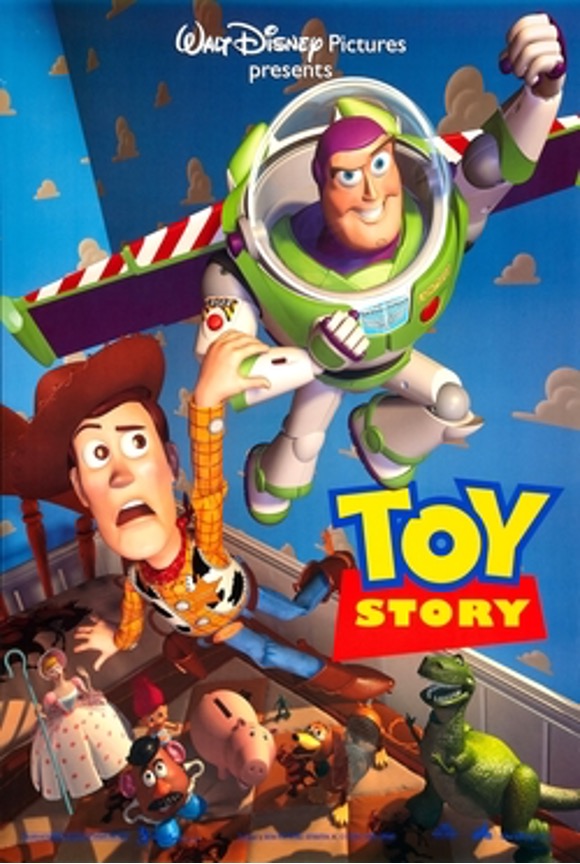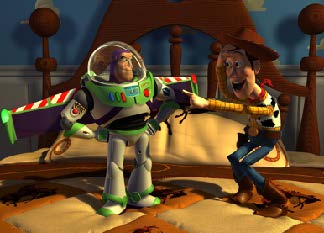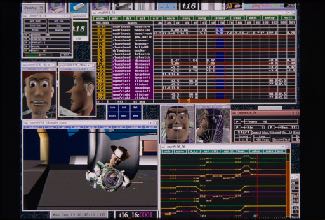The film Toy Story was much, much more than a film about a boy and his toys. It was a landmark in computer graphics animation and holds the distinction as the first fully computer-animated feature film. It also marked the dawn of 3D animated feature films. At Siggraph 2025, there will be a special event to celebrate this technical milestone. It will feature a keynote from Pixar co-founder Ed Catmull, a 4K screening, and a deep dive into the technical breakthroughs that made the film possible—many of which were born from the Siggraph community.
Talking toys like we’ve never seen before? Using the “new” 3D animation technique to create a full-length feature film? Could it be done? Would it be successful? Is this the future of animation? Yes, yes, yes, yes, and yes.

(Source: Wikipedia; copyright Disney/Pixar)
Thirty years ago, in 1995, Pixar Animation Studios released Toy Story, the first all-computer-animated feature film, setting a new standard in animation and storytelling. It introduced us to a number of unforgettable characters, including cowboy Woody and space ranger Buzz Lightyear, not to mention iconic toys come to life—little green army men, Mr. and Mrs. Potato Head, a Slinky dog, a T-rex figurine, a piggy bank, and more. The movie was a huge box-office success, spawning three hugely successful sequels, a spin-off movie, and animated TV series, a theme-park land, and more, including a fifth feature to be released next year.
In every way imaginable, Toy Story has been truly groundbreaking. Everyone remembers the film for its amazing animation, characters, and storytelling. And, many Siggraph veterans remember Toy Story for its technical innovations as well. More would follow with each subsequent film.
In recognition of the franchise’s achievements and contributions to the world of computer science, Siggraph 2025 will host a special tribute in celebration of the innovative film at 12:30 pm PDT on August 10, the first day of the conference, when it kicks off at the Vancouver Convention Centre in Vancouver, BC.
From RenderMan to real-time lighting models, Toy Story helped define the modern CG pipeline.
“Toy Story’s place in history is a remarkable milestone for computer graphics,” said Dawn Fidrick, Siggraph 2025 Computer Animation Festival director. “It showed that CG wasn’t just about producing images—it proved CG images could create the illusion of life, emotion, and storytelling. It paved the way for everything that followed.”

(Copyright Disney/Pixar)
Taking attendees back to where the magic (and CG revolution) started, the event, presented by Siggraph’s Computer Animation Festival in partnership with ACM Siggraph Pioneers, will include a special introduction by Ed Catmull, co-founder of Pixar and a pioneer in the field of computer graphics. In that introduction, titled “Pioneers Featured Speaker: Catmull Story: To SIGGRAPH and Beyond,” Catmull will reflect on the various breakthroughs, challenges, and triumphs that made Toy Story possible. There will also be a live Q&A with the audience, along with trivia and giveaways. Capping off the celebration will be a special 4K screening of the film.
As Siggraph points out, the tribute to Toy Story is more than a celebration of this past watershed accomplishment. It is a call to the next generation of dreamers and pioneers to keep pushing, collaborating, and telling stories that change the world.
Toy Story is as much a Siggraph story as it is a Pixar story. As Catmull notes, the technical hurdles required to make this film were tremendous—rendering realistic surfaces, modeling characters, and creating lifelike lighting—were challenges no one had solved for feature-length storytelling. But, there were researchers and artists at the time offering cutting-edge techniques and breakthroughs at the annual Siggraph conference in various papers, presentations, and conversations.
“Siggraph wasn’t just a conference; it was our lifeline,” Catmull said to Siggraph. “We published everything we did because we believed in growing the field together. The breakthroughs shared openly at Siggraph—on lighting, shading, rendering—they became the building blocks that we stitched together to make Toy Story.”
At Siggraph, innovations such as new illumination models from Cornell, early ray tracing from the University of North Carolina, stochastic sampling methods developed at Lucasfilm, and advancements that led to the creation of Pixar’s RenderMan were all born from SIGGRAPH papers and conversations.

(Copyright Disney/Pixar)
Before the world was introduced to Buzz, Woody, and the gang, Siggraph attendees even got a glimpse of this brand-new world when Pixar presented early test footage at the conference. What the studio was doing was met with approval and appreciation, and substantial applause, from fellow industry practitioners. Bill Reeves, supervising TD of Toy Story, told Siggraph that at that moment, they knew they were on to something big.
Still, Toy Story was a risky experiment, as highlighted by a quote from Pete Docter, supervising animator on the film and current Pixar chief creative officer. “Looking back on making Toy Story, I realize now that none of us really knew what we were doing. At the time, it didn’t feel that way; the young, talented team was brimming with confidence and optimism, too inexperienced to seriously consider that the whole thing might fail. Maybe that is why it worked. What we did understand early on was that the film’s success would depend on the strength of its story and characters. Without that, even the world’s first fully computer-animated feature would just be a gimmick.”
Now, 30 years later, people around the world are still enjoying Toy Story and its sequels, shorts, and theme park attractions, so I guess we did something right, he added.
Toy Story was a dream that became a reality, making Pixar a top animation studio against which others would be measured. Not resting on its laurels, Pixar earned itself a reputation for its ability to blend art/storytelling and technology, and they did so hit after hit.
Over the years, Pixar has created many endearing characters, each special in their own way. However, the characters from Toy Story are particularly special, withstanding the test of time and cementing their place as pop-culture icons.
Indeed, it is a Toy Story world, and we are very fortunate to live in it.
Editor’s note: I was the chief editor at Computer Graphics World when Toy Story 4 was released in the summer of 2019. In celebration, we dedicated the issue to the cutting-edge CG accomplishments of each Toy Story film by re-running the original CGW articles chronicling the technical achievements on the first Toy Story through the third, all written by longtime contributor Barbara Robertson, and the fourth, which I wrote. I recommend this walk through animation history to see how far each subsequent film had advanced the art of animation and storytelling. The articles are still available online at CGW here for an intro setting the stage and the first three films, and here for the then current film, Toy Story 4.
LIKE WHAT YOU’RE READING? INTRODUCE US TO YOUR FRIENDS AND COLLEAGUES.